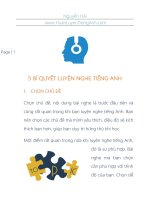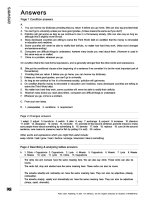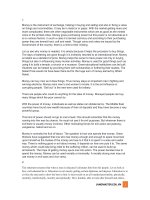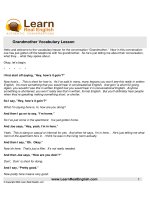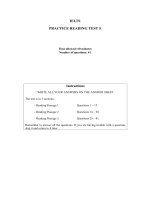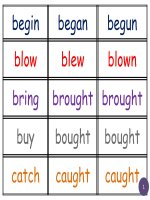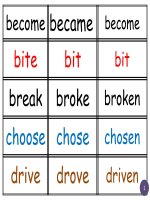Business result pre intermediate students book reduced kho tài liệu học tiếng anh
Bạn đang xem bản rút gọn của tài liệu. Xem và tải ngay bản đầy đủ của tài liệu tại đây (33.75 MB, 164 trang )
Business
Result
Pre-intermediate I Interactive Workbook
Available from
September 2012
Business Result Interactive Workbook content is also
available online. You can access the material from your
Interactive Workbook on DVD-ROM at the back of this book
or on line at www.oxfordlearn.com/login
To access the online content, follow these instructions:
Use a coin to scratch off the panel below to reveal your code
Go to www.oxfordlearn.com/ login to activate your code
• Follow instructions online to register
• Don't share your access code with anyone else. Only one person
can use each code
The online content can be used for 12 months from the date the
code is activated
• For help, contact customer service:
Business
SU
Pre-intermediate I Student's Book
David Grant, Jane Hudson & Robert McLarty
Interactive Workbook material
by Gareth Davies, Chris Speck & Shaun Wilden
OXFORD
UNIVERSITY PRESS
I
!
I Introduction
1 Companies
16-11 1
~ I
Working with words
Language at
work
Practically
speaking
Business
communication
Case study I
Activity
Outcomes - you can:
Company facts
Present simple
How to
make polite
requests
Socializing
Introducing
yourself and
others
Make that
contact!
• talk about what
companies do
produce, specialize in,
head office, competitor,
employee, etc.
• talk about your company
• make polite requests
VIDEO
2
Contacts
112- 17 1
Describing your job
and job contacts
• introduce yourself and other
Present
continuous
consist of, involve,
take part in, colleague,
consultant, customer,
etc.
How to
say phone
numbers and
spell names
Telephoning
Making and
receiving
telephone calls
Dealing with
a public
relations
crisis
Visitors
Company structure
118-23 1
in charge of,
responsible for, human
resources, etc.
• talk about work activities
• give phone numbers and
spell names
• make and receive telephone
calls
VIDEO
3
• talk about your job and the
people you work with
Asking
questions
How to
welcome
visitors
Presenting
Visual
information
The question
game
• talk about company structur
• ask questions
• welcome visitors
• present visual information
VIDEO
4
New
products
124-29 1
The development
process
launch, do market
research, do product
trials, economical,
practical, etc.
Past simple
VIDEO
How to show
interest
Meetings
Giving a report
Re-launching
an exhibition
centre
• talk about new products
and the stages in their
development
• talk about the development
of products
• show interest
• give a report
5
Employment
130-35 1
6
Customer
service
136-41 1
7
Travel
142-47 1
Job benefits and
employment
procedures
annual bonus,
matemity leave, paid
holiday, apply for, fill in
a form, etc.
Present
perfect (1)
Customer satisfaction
meet the needs of
customers, deal with
complaints, keep to
your delivery dates.
dissatisfied, loyal, etc.
Comparisons
Travel
check in, departure
lounge, delay, facilities,
key card, etc.
Countable and
uncountable
nouns
How to
delegate work
VIDEO
Orders
Orders and deliveries
148-53 1
place an order,
purchase goods,
process an order. in
stock, etc.
Solving
recruitment
problems
• talk about job benefits and
employment procedures
• describe personal
experiences
• delegate work
• discuss progress on projects
How to
respond to
complaints
Rewarding
good
customer
service
• talk about customer service
Socializing
Making small
talk and
developing a
conversation
The travel
game
• talk about travel
Meetings
Making and
responding to
suggestions
Choosing
a delivery
company
Meetings
Asking for and
giving opinions
VIDEO
How to report
to a company
Reception
VIDEO
8
Meetings
Discussing
progress
Present
continuous,
going to, Will
for plans,
arrangements,
and decisions
How to make
arrangements
• make comparisons
• respond to complaints
• ask for and give opinions
• ask for travel information
• report to a company
reception
• make small talk and developl
a conversation
VIDEO
• talk about orders and
deliveries
• talk about the future
• make arrangements
• make and respond to
suggestions
Working with words
Language
at work
Practically
speaking
Business
communication
Case study I
Activity
Outcomes - you can:
no
::I
9
Selling
154-59 1
Sales and advertising
enter a market,
improve market share,
advertising campaign,
word-of-mouth, etc.
VIDEO
New
ideas
160-65 1
Green initiatives
Entertaining
Corporate
entertainment
166-71 1
2
Performance
172-77 1
Modal
verbs for
obligation,
necessity,
and
permission
How to
interrupt
and avoid
interruption
The passive
How to
ask for
clarification
Meetings
Controlling the
discussion
Promot ing
to the youth
market
Future
trends
178-83 1
• talk about obligation
• Interrupt and avoid being
Interrupted
• cortrol the discussion in
meetings
affordable, convenient,
environmentally
friendly, popular,
initiative, etc.
Presenting
Giving a formal
presentation
Making a
company
carbon neutral
VIDEO
How to talk
about food
and drink
First
conditional
purpose, event, host
company, venue,
budget, entertain
clients, etc.
Socializing
Invitations and
offers
Organizing a
successful
corporate event
VIDEO
• talk about new green initiatives
• talk about Innovative practices
• ask for clarification
• give a formal presentation
• talk about corporate
entertainment
• talk about future possibilities
• talk about food and drink
• make and respond to invitations
and offers
Evaluating performance
manage costs,
perform well, socially
responsible, safety
record, etc.
Present
perfect (2)
with for and
since
How to say
numbers
Presenting
DeSCribing
trends
The
performance
game
• talk about performance
• talk about present and past
performance
• say large and approximate
numbers
VIDEO
3
• talk about sales and advertising
• describe trends
Global issues
global demand,
economic development,
forecast, run out, etc.
Future
predictions
How to
respond to
ideas
Meetings
How to
use time
expressions
Exchanging
information
Predicting
Modernizing a
company
• talk about global Issues
• make predictions
• respond to Ideas
• predict future trends
VIDEO
4
Time
184-89 1
Managing time
Second
conditional
waste time, meet a
deadline, save time,
on time, etc.
Negotiating
new schedules
Negotiating
conditions
• negotiate conditions
Training
Personal development
and training
190-95 1
improve performance,
set goals, motivate,
give feedback, etc.
How to say
thank you
and respond
Modal verbs
for giving
advice
VIDEO
6
Your career
196-101 1
Careers
career path, make a
decision, concentrate
on, give up, strengths,
weaknesses, challenge,
etc.
Practice files
• speculate and discuss
consequences
• talk about time
VIDEO
5
• talk about managing time
ReVision of
grammar and
tenses
Showing
understanding
and suggesting
solutions
Presenting
G'vlng a personal
prese n aLlC'1
VI DEO
Introducing
personal
development
programmes
• talk about personal
development and training
• give advice
• say thank you and respond
• show understanding and
suggest solutions
Ambition!
• talk about ambitions and
careers
• revise grammar and tenses
• say goodbye
• give a personal presentation
1102-1331
Irregular verb list
How to say
goodbye
Exchanging
information
11341
Information files 1135-146 :
Audio scripts
1147-159 i
VIDEO : This section of the unit has a video clip linked to the topi c.
S
::I
....
'"
Introduction
Welcome to Business Result Pre-intermediate. In this book you
will find:
I 16 units I Practice files I Information files I Audio scripts I
I Interactive Workbook on DVD-ROM I
What's in a unit?
Starting point
• an introduction to the unit
• discussion questions
Working with words
• reading and listening about the world of work
• new words and phrases that you can use in your work
• practise the new words in speaking activities
Language at work
•
•
•
•
grammar lessons in real work situations
helps you communicate better
practise grammar in the classroom in speaking activities
for more practice go to the Practice file
Practically speaking
• essential words and phrases for general use
• helps you sound more natural when you speak English
Business communication
• key expressions for exchanging information, socializing,
presenting, and meetings
• real work situations
• Key expressions list in every unit
Case st udy / Activity
• authentic case study, or activity
• improve your fluency
• practise the language from the unit
What's the Interactive Workbook on
DVD-ROM?
The Interactive Workbook lets you practise the language from the
Student's Book. It also helps you test your own progress. Use it at
home or in the office to practise the language you learn in class.
Exercises and Tests
• practise key language with interactive exercises
• check your progress with unit tests
Glossary
• check the meaning of over 400 words and phrases
• listen to the words and add your translation
Phrasebank
• listen to the key expressions from the Student's Book
• learn new phrases for telephoning, exchanging information,
socializing, travel, presenting, and meetings
• create your personal phrasebook
• learn useful phrases for writing emails
• copy example emails to use at work
Listen again
• listen again to the Student's Book audio, or download to your
MP3 player
Video
• Watch a video clip related to a section in the unit. Every unit
has a video clip which recycles and extends the language of the
unit.
• Complete the interactive exercises while you watch the video
clips
• This icon VIDE O shows you the section of the unit that the
video relates to. Watch the video after you have completed the
work in the Student's Book.
@ » Interactive Workbook »
What's in the Practice file?
Written exercises on the key language in
• Working with words
• Business communication
• Language at work
plus a language reference section with more grammar
explanations.
Use the Practice file
• in class to check your understanding
• after class for extra practice.
Follow the links to the Practice file in each unit
» For more exercises, go to Practice file 3 on page 106.
Fast-track option
If you are on a short course, you can do the fast-track option. For
each unit, do Language at work, Practically speaking, and Business
communication in class. You can do the other sections in your own
time if you wish.
How to use Business Result Pre-intermediate I A compLete bLended Learning package
-...::::J
,...
Student's Book I Main unit
o
In class: Learn vocabulary, grammar, and expressions with listening, reading, and speaking activities.
._------_..
C
,-_._-----
,."--'-"--"-~---"-~--
.~===.:=..,"=,,!:==
-~.-
_-
-_..
Self-study: When you see this, go to the
Interactive Workbook on your DVD-ROM.
In class or self-study: When you see this, go
to the Practice flles at the back of the book
» the
For more exercises, go to
Practice files .
@
Student's Book I Practice file
M';;;;iiiNm
----
•
W~~~I~~
...
.---~-
! :~~f?}:f:?:..-·--- ~.0':
::::::-=--:::.":':"".:=...:::::"~
--
.:;:::--=.:..:.:==.-==.
.--.-------,-
====---==-..::.-=:--
er
::::J
.-~-----
.=-
. --.----~-.,-
·~~=7-~~~i~
.-_._-_._-_._-
=.-===-':.::::'.-:::':::::::"
n
,...
'::;::. -~-==-._-----._--- - ._- -------
: :~:!:::-==::::~~:-
'Fl~I~~=~
Q.
»
Interactive Workbook
»
Interactive Workbook
....
f=~'
".
•.•...
.-----
Ullit 7
Click on an exercise to begin
Onlt9
Unit 10
unit 11
Unit 13
Unit 14
U"lt15
Business Result online
Self-study: You can access the Business
Result website by either following the
prompts on your CD-ROM, or by going
to www.oup.com/eltlresult
Unlt Ui
www .oup. com/elt /ruult
o
EXIT
• Exercises & Tests
• Emails
Interactive exercises:
• Working with words
• Business communication
• Phrasebank
Reference material:
• Tips on writing
• Glossaries
• Student's Book grammar
explanations
• Practice file answer key
• Student's Book audio
• Personal phrase book
• Glossary
• Video with interactive exercises
and more ...
5
Working with words I Corn pa ny facts
Starting point
1 Look at the pictures
on this page. What do
you know about these
companies?
2 Do you think it's better
to work for a large or a
small company?
3 What kind of company
do you work for?
1 Read these descriptions of some companies. Complete their names.
This company provides many different Internet services, including news, online
shopping, and email. Most of its sales come from advertising on its website. Its
head office is in Sunnyvale, California.
y----
2 This company produces tyres for cars and other vehicles. It is based in France,
but it has more than 125,000 employees all over the world. It is also well known
for its red and green travel guides.
M_ _ _ _
__ _
3 This northern European company operates in the retail market. It specializes in
low·price products, including furniture, bathrooms, and kitchens.
1_ _ _
4 It's a subsidiary of the European Aeronautic Defence and Space Company (EADS).
The company makes planes for the commercial aircraft market, where its main
competitor is Boeing.
A ____ _
5 This company makes many different electrical and electronic products, such
as TVs, computers, and mobile phones. It is South Korea's largest company and
exporter.
S_ _ _ _ _ _
2 Complete these sentences with the words in bold in 1.
1 Some companies make or
goods.
2 Other companies
or offer services.
3 If you
in a particular product or service, it's your main activity.
4 If you work for a company, you are an _ __ _
5 If your head office is in a particular city, your company _ __ ___ _ _
there.
6 If you work in a
, your company is part of a bigger group.
7 If you sell a lot of products, your
are very good.
8 If another company operates in the same market as you, it is your _ _ _ _
» For more exercises, go to Practice file 1 on page 102.
_.
,...
~
3
Work with a partner. Make sentences using the words in the table.
Gazprom
4
Pirelli
produces / makes ...
specializes in ...
AOL
operates in ...
Mitsubishi
Volkswagen
provides / offers ...
sells ...
UNICEF
's competitors are ...
01!> An employee is talking about her company. Listen and complete the
information in the table.
Name of company
Products
BESAM
1A _ _ _ _ 2d _ _ __ mechanisms: locks and
3S
systems
Group
Nationality
Assa Abloy
Number of employees
Sales
Number of subsidiaries
Other information
5
4S _ _ __
_ _ _ ,000
6€ _ __ _ billion
in 40 countries
Main Bc
are the Eastern Company,
Ingersoll-Rand, and Master Lock
Work with a partner. Talk about Besam, using some or all ofthese phrases
and the information in 4 .
It's a(n) ... company / organization.
It's a subsidiary of ...
Its head office is ...
It makes / produces ...
It provides / offers ...
It has ... employees
It operates in ...
It specializes in ...
It is based in ...
Its main competitors are .. .
It has sales of ...
6 Now talk about your company using the phrases in 5.
@ » Interactive Workbook » Glossary
Language at work I Present simple
1 Work with a partner. Ask and answer these questions.
1
2
3
4
5
Do you work for a multinational company?
Is it a new company?
What does it do?
Does it operate in many countries?
Where do you work?
2 Match the questions in 1 to answers a-e.
a
b
c
d
e
3
Yes, it does. _
It provides engineering services to the car industry. _
I have an office in London and another in Tokyo. _
Yes, I do. _
No, it isn't. _
We use the present simple to talk about general facts or regular actions.
Find examples in 1 and 2 for each of these rules.
1 In the third person singular (he / she / it), the verb ends in -s or -es.
Example: _ _ _ _ _ _ __ __ _ _ _ __
2 With I / you / we / they, there is no final -so
Example: _ _ _ __ _ __ __ _ _ __ _
3 In most questions, use do with I / you / we / they and does with he / she / it.
Example: _ _ _ _ __ _ __ __ __ __
4 Don't use do and does in questions with the verb to be.
Example: _ _ _ _ _ _ __ _ __ _ _ __
»
For more information and exercises, go to Practice file 1 on page 103.
4 Read the text. Discuss the questions with a partner.
When you see the name Nestle, perhaps you think of breakfast
cereals, Nescafe instant coffee, or Nespresso machines. But what
else do you know about the company? What other products does it
sell, and where? How many people work for the company and why
do they like working there? What does the company do to protect
the environment?
Listen to Nestle in Focus tonight at 8.00 p.m. to get answers to
these and many other questions.
5
Tip I Questions with
prepositions
In a question with a
preposition, the preposition is
usually the last word, not the
first.
Where is he from?
Who do you work for?
What market do you sell in?
Work with a partner. Make questions about Nestle using the prompts below.
Example: How old is the company?
1 How old / company?
2 What products / company / specialize in?
3 What / its annual sales?
4 Where / its head office?
5 How many factories / have?
6 company / sell / products / all five continents?
7 How many people / employ?
8 What / offer / its employees?
9 company / a lot of work in the community?
10 How / protect the environment?
6 021> Match answers a-j to questions 1-10 in 5. Then listen to the radio
programme and check.
a 780. _
b More than 140 years old. _
c Yes, it does. _
d 276,000. _
e More than 107 billion Swiss
francs. _
f Many possibilities for training. _
g Yes, it gives money and other help. _
h Food and beverages. _
Vevey, Switzerland. _
j By using less water, energy and
packaging. _
c:
:::s
::;:
()
o
:3
-0
7 Make sentences about Nestle, using the questions in 5 and answers in 6 .
Cl.)
:::l
Example: The company is more than 140 years old.
(!)
V'I
8 Work with a partner. Ask and answer the questions in 5 about your
company.
9 Work with a different partner. Tell them about your first partner's
company.
Practically speaking I How to make polite requests
1 Complete these questions with I or you.
1
2
3
4
5
6
Could _ speak to you for a moment?
Can _ tell me your name?
Can _ have another drink, please?
Could _ call me again tomorrow?
Would _ repeat that, please?
Could _ help me for a moment?
2 031> Work with a partner. Match the questions in 1 to responses a-fbelow.
Listen and check your answers. Then practise the conversations.
a Yes, sorry. The reference is 1256 K. _
d Sorry, but I'm very busy. _
b Yes, of course. _
e Certainly. Same again? _
c I'm afraid I'm on holiday. _
f Sure. It's Woody Neilson. _
3 Work with a partner. Take turns to make and respond to requests, using
the verbs in brackets.
Example: Can I have your telephone number, please?
1
2
3
4
5
6
7
8
I want your telephone number. (have)
I want your address. (give)
I don't understand you. (speak more slowly)
I need your signature on this document. (sign)
I need two chairs for my table. You have two free chairs at your table. (take)
I don't have time to speak to you now. (talk later)
I need your pen to sign the visitor's book. (borrow)
I didn't hear what you said. (say)
Tip I can, could, and
would
Could and would are generally
more polite and formal tha n
can.
Would is not used with I:
Could I speak to you?
NOT 14lglJf.d ! speak to ytJlJ?
Business communication I Introducing yourself and others
1 04[> Gianluca Donatelli is at a conference. Listen to him introducing
himself to Jana Frkova. Make notes about
1 Jana's nationality
2 her job
3 why she's at the conference.
2 051> Complete what Gianluca says. Listen and check your answers.
1
2
3
4
5
6
7
Excuse me.
this seat free?
myself? I'm Gianluca Donatelli.
Thanks very much. Can I
Nice to meet you
,Jana. Where are you
?
And
do you work for?
Oh really? And what do you
?
So
are you at this conference?
That's interesting. A friend of mine works for an Italian service provider. Can I
introduce
to
?
8 Roberto. Can you come here for a minute? This is .. . Sorry, what's your name
- - -- ?
9 Roberto. _ _ _ _ is Jana. She's writing an article on Internet service providers.
3 051> Listen to Gianluca again. He asks Jana eight questions. Match Jana's
Key expressions
Introducing yourself
Can I introduce myself?
My name's / I'm .. .
Introducing others
Can I introduce you to .. .?
This is .. .
Responding
Nice to meet you /
How do you do.
Nice to meet you too.
Asking about a person I job I
company
What about you?
What's your name (again)?
Where are you from?
Who do you work for?
What do you do?
Why are you here?
@ » Interactive Workbook »
Phrasebank
responses to each question. Then work with a partner and practise the
dialogue.
1 ---.L
a I am a journalist.
2
b Jana. Jana Frkova.
3
c Yes, it is.
4
d Nice to meet you. I am Jana Frkova.
5
e I'm here to research an article on Internet service providers.
f I am self-employed.
6
7
g Yes, of course. That would be nice.
h I'm from the Czech Republic.
8
4 Why don't we learn much about Gianluca in the conversation in 1?
5 061> Listen to two extracts from a different version of the conversation.
1 What do we learn about Gianluca this time?
2 Underline the stressed words in Jana's questions.
1 What about you? What do you do?
2 What about you? What are you here for?
» For more exercises, go to Practice file 1 on page 102.
6 Work with a partner. Have short conversations. Talk and ask about these
things.
Example: A
B
A
• name
• country
Where are youfram?
I'mfram Spain. What about you? Where are you from ?
I'mfrom Japan.
• company
• reason for being here
• job
7 Work in groups. You are at a party at a conference. Introduce yourself and
find out about another person. Then introduce this person to other people
in the group.
@ » Interactive Workbook » Email and » Exercises and Tests
Work with a partner. You are both at a conference. You are competing
for a big customer. The first person to finish is the winner. Turn to File 01
on page 135 for the rules ofthe game.
PLAYER A
PLAYERB
Start
Start
Where are you
from?
I'm a sales
manager.
We make car
windows.
Who do you
work for?
Can I introduce
you to my boss?
How do you do?
It's 1263 Gray
Rd, Carmel.
*
JOKER '
What are your
annual sales?
In Milan .
No, I work
in one of our
subsidiaries.
What services
do you provide?
Where's your
head office?
No, we don't .
We're a service
company.
No, I'm
American .
* *
JOKER
Can you tell me
your hotel room
number?
My wife? She's a
journalist.
Yes , we do / No,
we don't.
Can I borrow
your pen?
Who are
your main
competitors?
* *
JOKER
Does your
company operate
in Europe?
Yes, sure. It's
Jan Olsen.
How many
employees do
you have?
Yes, I am. Nice
to meet you.
Is this seat free?
Sorry, what's
your name
again?
No, it's a French
company.
Italy
I'm Spanish.
What about you?
* *
J OKE R
Yes, it's
07 45 32 19 66.
We operate in
Europe and
North America.
What does your
company do?
JOKER
Do you use
English in your
job?
Yes, I am.
What do you
specialize in?
Yes, of course.
Please take it .
What does
your company
specialize in?
* *
I work for
Goodyear.
Does your
company have a
web site?
* *
JOKER
* *
J OKER
I'm in the Hotel
Cap Verde.
That's a very
personal
question!
Do you do any
business in Asia?
You speak very
good English!
Yes, of course.
I'll give you my
phone number.
Congratulations! You made contact with the customer first!
Working with words I Describing your job and job contacts
1 What do these people do in their work?
1 a retail buyer
2 a public relations officer
3 an occupational psychologist
2 Read the text quickly and compare your answers to 1.
Starting point
1 At work, who do you
usually speak to
1 byphone?
2 face-to-face?
2 Do you prefer
communicating with
people by email or on
the phone?
3
How much of your day
do you spend
1 speaking with people?
2 working alone?
I work for a supermarket
chain. My job involves
buying prepared salads
and vegetables from local
and national suppliers. I
also take part in different
logistics projects. For
example, at the moment
we're working with an
external consultant. He's
looking at ways to get our
salads and vegetables to
the supermarket shelves
more quickly.
I work for the police, but
I'm not a policeman. A
lot of my work consists
of answering questions
from journalists when the
police are in the news. I'm
also involved in a new
project to attract new
people to the police force.
For this, I'm working with
senior police officers and
with outside employment
agenCies.
I'm self-employed.
Basically, I deal with
problems of relations
between staff At the
moment, for example,
I'm doing a study on
virtual teamwork for
one of my industrial
customers. They work
with many subcontractors
all over the world, and
their managers want to
communicate better with
their colleagues abroad.
I work a lot with training
organizations which
provide the courses my
customers need.
3 Read the text again and complete the table.
Which person or people .. .
work(s) on problems of
communication?
work(s) with people outside
the company?
work(s) with products?
works with companies, but
not for a company?
Sara
Benjamin
Heidi
4 Work with a partner. Match the words in italics in the text to definitions a-h.
a
b
c
d
e
f
g
h
companies which sell their products to you _ _ __
organizations which find new employees for you _ _ __
companies which do work for you which you can't do yourself _ _ __
people who work in the same company as you _ _ __
organizations which offer courses to company employees _ _ __
a person from outside a company who gives expert advice _ _ __
companies which buy your products _ _ __
all the people who work for a company _ _ __
5 Work with a partner. Which people or organizations do you have contact
with in your job?
6 081> Sang Chun is talking about his job in a software company. Listen and
tick (./) the people that he works with and the jobs that he does.
People
Customers
Suppliers
Sales reps
Programmers
Jobs
Answering calls
Visiting
Developing new programs
Discussing old programs
7 081> Complete this description of Sang Chun's job with a form of the
phrases in bold from the text in 2 . Listen again and check your answers.
Main job
This
answering calls from customers who are having
problems with their software. It also
working with sales reps from
time to time.
Other tasks
He isn't
developing new programs. But when
programmers are preparing new versions of old products, he _ _ __
____ in the discussions.
Typical problems
He ________ installation issues, password problems, bugs, etc.
» For more exercises, go to Practice File 2 on page 104.
8
Work with a partner. Tell your partner about your job. What is similar to
your partner's job, and what is different?
• Main job
• Typical problems
• Other tasks (projects, etc.)
• People you work with inside and outside
the company
@ » Interactive Workbook » Glossary
Tip I verb / adjective
+ preposition + -ing
When a verb follows a
preposition, it always ends
with -ing.
My job consists of answering
the phone to customers.
He's involved in developing
new software.
Language at work I Present continuous
1 Work with a partner. Answer these questions.
1 What do you do?
2 What are you working on this week?
3 What are you doing at the moment?
2 Match the questions in 1 to answers a-c.
a I'm looking at ways to get our products to customers more quickly. _
b Basically, my job consists of answering customer calls. _
c I'm trying to improve my English. _
3 In 2 , sentences a and c are in the present continuous and sentence b is in
the present simple. Which tense do we use to talk about
1 a present action? _ __ _ _ _ __ __ _ _ _ __
2 a temporary project? _ _ _ _ __ _ _ _ _ _ __ __
3 a general fact or regular action? _ __ _ _ _ _ _ __ __ _ __
4 Complete this rule about the present continuous.
The present continuous is formed with the verb _ __ _ _ _ + -ing form.
5 Work with a partner. Look at these signs. Where would you see them?
b
ACCESS DENIED
Lift out of order
Please check pa~sword
d try again.
Please use stai r,
an
.---
M[;f-rl tJ ~
.. Automatic reply: I am out
IN
p/l..O{;(~fSS.
Db
6
I
of the office until 19th March.
NOT" l>ls,-,,/lI!.·
091> Listen to two conversations and match them with two of the signs
in 5.
1 _
2 _
7
091> Complete conversation 1 with the present continuous form ofthe
verbs in the list. Then listen again and check your answers.
have
accept
A Who _ _ __
try
speak
work
_ ___ to?
to access my customer files , but
B Sorry, this is Nadira. I
the computer
my password.
A ... There's a problem with the server.
B
somebody
on it at the moment?
A Yes, I am. But it's not easy, because I'm on my own here. Everybody else
_ _______ lunch.
8
09 t> Work with a partner. Listen to conversation 2 again. Have a
conversation using the prompts below.
A Excuse me.
B What? Meeting!
A Who?
B A supplier. New prices. Why / disturb?
A Somebody / room.
B This room / every Monday.
A Sales Director / priority.
B He / wait / now?
A Yes.
B OK. I / leave.
»
N
For more information and exercises, go to Practice File 2 on page 105.
(')
o
9 Work with a partner. Take turns to ask and answer questions, using the
present simple or present continuous form
• speak / English at work?
•
• travel / a lot for your work?
•
• travel/anywhere this week?
•
• sometimes / work / special projects?
•
• do / any other training courses
•
at the moment?
:J
r-t
OJ
of the prompts below.
receive / any visitors / this week?
boss / work / every day?
he / she / work / today?
he / she / travel / a lot for work?
he / she / travel/this week?
("')
r-t
VI
@ » Interactive Workbook » Email
Practically speaking I How to say phone numbers and
spell names
1
lOt> Listen and write the phone numbers you hear.
1 The code for England is _ _ _ __ _ _
2 My mobile number is _ _ __ __ _
2 Work with a partner. Say your home, work, and mobile phone numbers to
your partner. Write down what your partner says.
3
ut> Listen to two conversations and write the names.
1
2
4
Work with a partner. Spell your first name, last name, and the name of
your company to your partner. Write down what he / she says.
Tip I Saying phone
numbers
We usually say each number
separately, except when two
consecutive numbers are the
same.
The code for Thailand is
double oh double six (00 66).
In American English, we say
zero and not oh for O.
Business communication I Making and receiving
telephone ca Us
1 121> Listen to two telephone conversations and answer the questions.
1 Which conversation is between
a a consulting company and a sub-contractor? _
b a supplier and a customer? _
2 What is the reason for each call?
2
121> Match sentences 1-5 with responses a-e. Then listen to Conversation 1
again and check your answers.
1 Is Mrs Ackers there, please? _
2 Who's calling, please? _
3 What can I do for you? _
4 Can I call you back tomorrow? _
5 Thanks for calling. _
a
b
c
d
e
This is Simon Ilago from AOS.
I'm calling about a special price on our printers.
Speaking.
You're welcome. Goodbye.
Sorry, but I'm out of the office tomorrow.
3 121> Which sentences and responses in 2 are said by the caller and which by
the receiver? Listen to Conversation 1 again and check your answers.
Key expressions
Asking to speak to someone
Could I speak to (name)?
Is (name) there, please?
Identifying the caller
Could I have your name ,
please?
Who's calling, please?
This is (your name).
4 Work with a partner. Take turns to be the caller and the receiver. Have
similar conversations using your own names.
Call 1: You want to arrange a meeting to present your products.
Call 2: You want to ask about payment of an invoice.
5
Giving a reason for the call
I'm calling about ...
I'm phoning to ...
Could
Saying the person is I isn't free
I'm sorry, but / I'm afraid she's
not here today.
Can I take a message?
Leaving a message
Can / Could I leave a message?
Can / Could you ask him / her
to call me back?
Finishing
I'll give him / her the message.
Thanks for your help / for
calling.
Speak to you later / tomorrow.
@ » Interactive Workbook »
Phrasebank
121> Work with a partner. Make five questions using the words in the table.
Listen to Conversation 2 again and check your answers. What are the
responses to each ofthe questions? Practise the questions and responses.
»
6
you
speak
leave
have
ask
tell
Leo to call me back?
me what it's about?
your name , please?
to Leo Keliher, please?
a message?
For more exercises, go to Practice File 2 on page 104.
Work in groups ofthree. Have three phone conversations.
Student A Call Student B. Ask to speak to Student C. You're an ex-colleague.
You want to meet him / her for lunch or dinner tomorrow. You're only in town
for one day.
Student B Student A calls you. You work with Student C. He / she is very
busy and wants you to answer all phone calls. Ask who's calling and why, then
call Student C and give him / her the message.
Student C Student B calls you. Listen to the message then call Student A.
Decide together if you can meet tomorrow.
@ » Interactive Workbook » Exercises and Tests
ealing with a public relations crisis
ackground
Crisis? What crisis?
Sometimes a crisis in a company can be used as an opportunity for good public
relations.
In 1982 seven people died after taking medicine produced by a big American
pharmaceutical company. They had bought the contaminated medicine from
different shops in the USA. It was discovered that somebody had put cyanide
poison in the bottle.
The company's sales quickly fell to just 8 % of the total market. The company
knew that it had to deal with the situation quickly to protect its customers and
its good name. Just six months later, it was once again the market leader, with
35% of sales in its market.
Discussion
Imagine that you are one of the directors of this company.
What can you do
1 to protect your customers?
2 to develop your business again?
3 to stop a crisis like this happening again?
Thrn to File 02 on page 135 to see what really happened.
Task
You work for the local branch of an international cosmetics company.
A hospital nearby has recently had several patients complaining of severe
skin reactions to a new moisturizer you produce.
Work with a partner. Have two phone conversations. Student A, turn to
File 03 on page 135. Student B, turn to File 36 on page 142 .
2 Work in small groups.
1 Discuss who else you need to tell about this problem, w ithin your
company and outside your company, and why.
2 Decide what action you will take and why.
3
Share your ideas with the rest of the class.
Working with words I Company structure
1 Read the text and answer the questions.
1
2
3
4
1 Do you visit other
companies? If so, why?
Who do you go with?
2 What sort of people
visit the department
you work in? Why?
3 Make a list of five
departments you find in
a company.
18
What was the aim of the customer visit programme?
How was it different from other programmes?
Which departments participated in the visits?
Was the programme a success? How?
The importance of
customer contact
The American computer manufacturer Hewlett-Packard ran a very successful
customer visit programme. The idea of the visits to HP customers was not to sell the
company's products, but simply to listen and learn.
The visits were conducted by mixed teams who visited between ten and forty
customers. These teams included a project engineer from the Research and
Development Department, and a person from Marketing who played a part in putting
the product on the market. In most
cases, a sales rep who was responsible
for each customer was also present.
In a questionnaire, 88% of staff
involved in the programme said that
customer satisfaction was better
as a result of the visits. About 90%
indicated that the visits gave them
ideas for changing the products or
services offered to customers.
This programme showed the value
of customer contact for all employees
in an organization. In so many
companies, it is only those who work
in Sales, Marketing, Customer Service,
or Technical Support who have direct
contact with customers.
2 Which department in the text in 1 usually
1 sells the products? _ _ __
2
3
4
S
3
looks for new markets for new or existing products? _ _ __
creates new products? _ _ __
answers technical questions from customers? _ _ __
answers all other questions from customers? _ _ __
Complete the sentences about other departments with words from the list.
finds
buys
checks
tl.'7f1Rges
maintains
deals
organizes
1 The Logistics Department arranges the transport of products.
2 The Training Department
courses.
from suppliers.
3 The Purchasing Department
4 The Human Resources Department
new staff.
S The IT Department
the computer system.
6 The Finance Department
with all the money.
7 The Quality Control Department
that the products have no defects.
4 Work with a partner. Take turns to make sentences about different people
who work in a company and to guess which department they work in.
Example: A She deals with all the money.
B She works in the Finance Department.
5
13t> Three people are receiving visitors from other departments in their
company. Listen to the three conversations and complete the table.
Person
Which department does he /
she work in?
Which department does his /
her visitor work in?
1
2
3
6 13t> Listen again and complete these sentences.
1 I have a meeting today with Anna Neves, who's ________ our
software.
2 Our company is _ ___ ____ three business units.
3 He's the person in
buying for the whole group.
4 I
a lot of training organizations.
S
the HR Director.
»
7
For more exercises, go to Practice file 3 on page 106.
Work with a partner. Ask and answer questions about your own job.
1 Which department do you work in?
2 What are you responsible for?
3 Who is in charge of your department?
4 Who do you report to?
S Which department(s) do you have most contact with? Why?
6 Is your department divided into different sections or units? What are they?
8 Work with a different partner. Take turns to describe your job and
department. Then describe the other people and departments around you.
@ » Interactive Workbook » Glossary
;::;:
W
<
VI
M-
O
-.
VI
Language at work I Asking questions
1 Work with a partner. Complete the questions. Then take turns to ask and
answer them.
1 _ _____ _ _ people does your company employ?
2 _ ___ did your company open in your town?
3 _ __ _ department do you work in?
4 _ _ __ often do visitors come to your company?
5 _ ___ are you working on at the moment?
2
Look at the word order for questions in the table. Then complete the table
with the questions in 1.
Question
word or
phrase
Auxiliary
verb
Subject
Main verb
Rest of
question
How often
do
you
speak
English?
How many
people
does
y our company
employ?
3 14 1> An employee is showing a visitor round her company. Listen to extracts
1-4 and decide where they are or who they are meeting in each one.
1 Where:
3 Where: _ __ _ __ _
2 Who: _ _ _ _ _ __
4 Who: _ _ __ _ __
4 Work with a partner. Put questions 1- 8 in the right order.
Tip I which and what
Which and what are very
similar, but there is one main
difference in meaning.
We use which when there is a
limited choice of answers.
Which city do you prefer Rio or Buenos Aires?
Which department do
you work in? The Sales
Department.
We use what when we are not
thinking of a choice.
What does your company
produce?
1
2
3
4
5
6
7
8
this / often / use / How / does / office / he ?
from / does / he / come / Where?
long / are / here / staying / How / you?
see / you / here / while / want / do / to / you're / Who?
open / did / it / When ?
do / receive / calls / a day / How / you / many?
you / do / Which / visit / countries?
about / much / you / market / know / the / How / Polish / do ?
5 141> Match questions
1-8 with responses a-fbelow. Then listen again and
check your answers.
a One or two people in Sales and Marketing. _
e Just two days. _
b In January. _
f New York. _
c Sweden and Denmark mostly. _
g About one day a week. _
d Not very much. _
h About 500. _
» For more information and exercises, go to Practice file 3 on page 107.
You have a new employee in your department. He / she has a lot of
questions for you. Make complete questions using the prompts.
Person in charge of department?
5 Photocopier?
Opening / closing hours?
6 Number of people?
3 earest toilets?
7 Key or security pass?
Lunch?
8 Coffee or tea breaks?
• ork with a partner. Take turns to ask and answer the questions in 6
ab out your departments.
ctically speaking I How to welcome visitors
15 1> You work for the Freebird Corporation in Lisbon. A customer is
visiting you for the first time. Complete sentences 1-7 with phrases from
the list. Then listen and check your answers.
Did you find ... ?
Where ... ? Did you get ... ?
Welcome ...
Would you like ... ?
How long ... ? Did you have ... ?
1
_ _ _ _ _ _ _ _ _ _ __ __ to Freebird.
2 _ _ _ __ _ _ _ _ _ _ __
a good trip?
3
your way here all right?
__ are you staying?
~ ---------5 _ _ _ _ __ _ _ _ _ _ __ _ are you here for?
6 _ __ _ _ __ _ _ __ _ _ _ something to drink before we start?
7
Its
the programme I sent you?
2
151> Listen again and write down the visitor's responses. Then practise the
conversation with a partner.
3
161> We often ask follow-up questions to develop a conversation. Listen
to a longer version of the conversation in 1. Then complete follow-up
questions 1-7.
1 Is this _ _ _ _ _ _ _ _ _ _ in Lisbon?
2 What time
last night?
3 How did you
- by car?
4 Is it _ _ _ _ _ _ _ _ _ for you?
5 Will you have time _ _ __ _ _ _ _ _ _ around Lisbon while
you're here?
6 How do you _ _ _ _ _ _ _ _ _?
7 Would you like to _ __ _ _ _ _ _ _ changes?
4 Work with a partner. Imagine someone is coming to visit you in your
company. Have a conversation with them, using the questions in 1 and the
follow-up questions in 3.
@ » Interactive Workbook » Email
w
<
VI
M
o.......
VI
Business communication I Presenting visual information
1 Look at the information about Lenovo, the computer manufacturer.
1 Which slide is in the form of
a a diagram?
b a graph?
c a pie chart?
2 Which slide shows
a rises and falls in market share?
b the breakdown of sales by market?
c some key figures in Lenovo's organizational structure?
1
2
Lenovo PC Market Share
(Mainland China)
Asia Pacific
Greater
China
12.9%
2_ _
40%~------------------~
3
30%
1_ _
01<
4
V
35.5%
31.3%
Lenovo in China
Main office/sales
Beijing
01<
3~0 3~ 35/0
%
34.5%
Americas
3
V
31.6%
R&D
5 cities
Production
cities
5__
%
FY06
FY07
FY08 Ql
* FY2004/05 market share information reflects
Lenovo 200718 results
* Europe. Middle East, Africa
After-sales
2417 call
centre
More than
technical
support
engineers
combined shares of Lenovo and IBM peD
2 171> Listen to a presentation about Lenovo and complete the missing
information on the slides.
3 17 1> Work with a partner. Which slide
1-3 does each sentence refer to?
Listen and check your answers.
a This pie chart gives you the breakdown of Lenovo's sales. _
b Note that the company has operations in many different cities.
c This graph shows the change in market share. _
d This diagram summarizes the company's main operations. _
e The important thing here is that Lenovo is still the market leader in China. _
f As you can see, 27.6% of sales are in the Americas. _
g But notice that China represents 37.5% of worldwide sales._
Key expressions
Referring to visuals
This table / pie chart / graph /
diagram gives you / shows /
summarizes ...
Let's look at this ...
Have a look at th is .. .
4 Which phrases in italics in 3 are used to
1 describe briefly what is in each slide? _, _, _
2 say what is important in each slide? _, _ , _ , _
5
Can everybody see that OK?
Is that clear?
Work with a partner. Choose two slides in 1. Cover the phrases in 3, and
take turns to present a slide. Describe each slide briefly and say what is
important about the information.
Focusing on important points
» For more exercises, go to Practice file 3 on page 106.
Checking
As you can see, .. .
Notice that .. .
Note that .. .
The important thing here is ...
@ » Interactive Workbook »
Phrasebank
6 Work with a partner. Student A, turn to File 04 on page 135. Student B,
turn to File 31 on page 141. Give a short presentation to your partner, using
the slides. Say what is important or interesting about the information.
@ » Interactive Workbook » Exercises and Tests
'ork with a partner. One of you is visiting the other's company. Take
:rrns to be the visitor and the host. Have a conversation in each 'place' in
- e table below. The aim of the game is to ask more questions than your
:>artner.
The host starts each conversation with the 'conversation opener'.
Use a question form in the 'Questions' column to continue the
conversation.
Use the ideas in the 'Subjects' column to help you.
Tick (.I) the 'Points' column every time you use one of the question
form s. You can use the same forms as often as you like, but try to use
them all before the end ofthe game.
The winner is the person who has the most points.
RECEPTION
Host: Nice to see you again. How are you? (1 point)
Visitor: I'm fine. Sorry I'm a little late. What time is it exactly?
Place
Conversation opener
Questions
Subjects
Points
(.I)
Reception
Nice to see you again.
Host's office
or desk
This is where I work.
Colleague's
office or desk
My colleague isn't here
today, but he / she ...
Another
department
Now we're in the (name)
department.
Meeting room
This slide shows the
structure of our company.
Restaurant
This is the best restaurant
in town.
Is ... ?
Are . .. ?
Do ... ?
Does ... ?
Did .. . ?
Can ... ?
Where . .. ?
What ... ?
Who . .. ?
Why . .. ?
When .. . ?
How ... ?
How often ... ?
How many ... ?
How much .. . ?
How long ... ?
Would y ou like ... ?
• Visitor's journey, hotel,
etc .
• Programme for visit
• Host's job and department
• Visitor's job and
department
• Colleague's job
• Visitor's work colleagues
• What it does
• Relations with host's
department
• Company structure and
key people
• Key people in visitor's
company
• Town where company
is located
• Visitor's home town
Total points *
* Give yourself 1 point for each tick.
Deduct 2 points for each question
form you haven't used.
